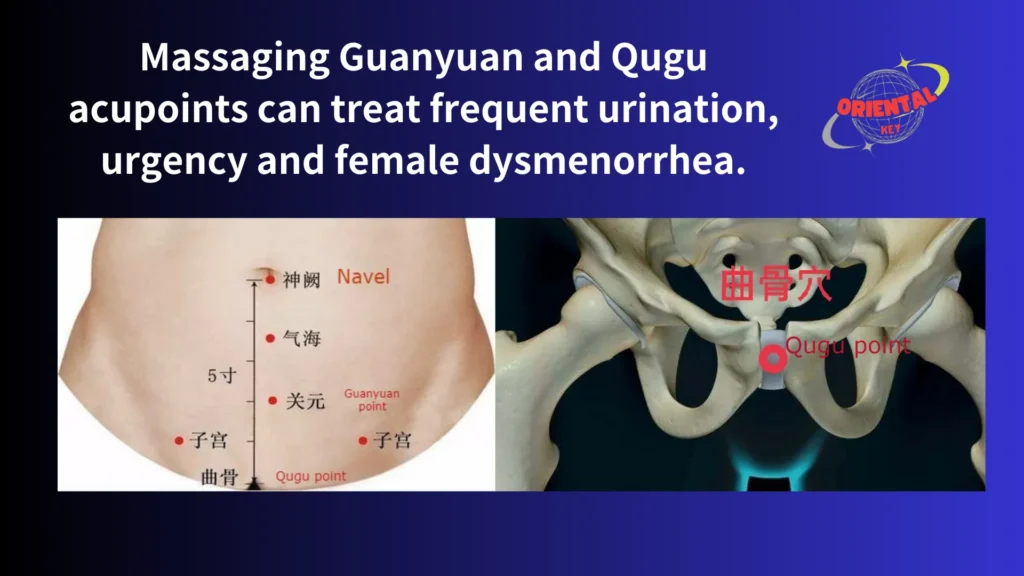Treating Frequent Urination, Urgency, and Dysmenorrhea Through Acupressure
Traditional Chinese Medicine (TCM) offers natural solutions for common health issues by targeting specific acupoints. Among these, the Guanyuan (CV4) and Qugu (CV2) acupoints are particularly effective for managing frequent urination, urinary urgency, and female dysmenorrhea. Below is a simplified guide to understanding these points, their massage techniques, and the principles behind their healing effects.
1. Introduction to the Acupoints
Guanyuan (CV4)
- Location: Four finger widths below the navel, along the midline of the lower abdomen.
- Function: Known as the “Gate of Original Qi,” Guanyuan strengthens the kidneys, regulates the bladder, and supports reproductive health. It is a key point for replenishing the body’s foundational energy (Qi).
Qugu (CV2)
- Location: At the upper border of the pubic bone, directly above the pubic symphysis.
- Function: Translating to “Curved Bone,” Qugu harmonizes Qi flow in the pelvic region. It addresses urinary disorders, menstrual cramps, and discomfort in the lower abdomen.
2. Massage Techniques
Step-by-Step Guide:
- Preparation:
- Sit or lie down comfortably. Relax your abdomen with deep, slow breathing for 1–2 minutes.
- Warm your hands by rubbing them together to enhance energy flow.
- Massaging Guanyuan (CV4):
- Use your middle or index finger to apply gentle, circular pressure to the Guanyuan point.
- Massage clockwise for 2–3 minutes, gradually increasing pressure if comfortable.
- Focus on smooth, rhythmic movements to stimulate Qi circulation.
- Massaging Qugu (CV2):
- Locate the Qugu point just above the pubic bone.
- Press gently with your thumb or index finger and massage in small circles for 2–3 minutes.
- Combine with deep breathing to relax the pelvic muscles.
Frequency:
- Perform daily, ideally in the morning or evening. Consistency is key—regular massage for 4–6 weeks often yields noticeable improvements.
Tips:
- Use a warm compress on the lower abdomen before massaging to enhance effectiveness.
- Avoid excessive pressure or massage during menstruation if cramps are severe.
3. Therapeutic Principles
- According to TCM theory, frequent urination, urgency, and dysmenorrhea are often linked to:
- Kidney Qi Deficiency: Weak kidney energy impairs bladder control and menstrual health. Guanyuan strengthens Kidney Qi, improving urinary function and reducing cramps.
- Qi and Blood Stagnation: Blockages in pelvic Qi or blood flow cause pain and urgency. Massaging Qugu promotes circulation, easing stasis-related symptoms.
- Cold Accumulation: Exposure to cold (e.g., cold weather, icy drinks) disrupts the lower abdomen. Warming and stimulating these points dispels Cold, restoring balance.
- Stimulating these acupoints may regulate nerve signals to the bladder and uterus, reducing overactivity and spasms.
- Enhanced blood flow to the pelvic area can alleviate muscle tension and inflammation, addressing both urinary and menstrual discomfort.
- Reduces urinary frequency and urgency.
- Eases menstrual cramps and pelvic discomfort.
- Strengthens overall pelvic and kidney health.
For more advanced content, go to https://health03.life/receive-rewards to unlock

